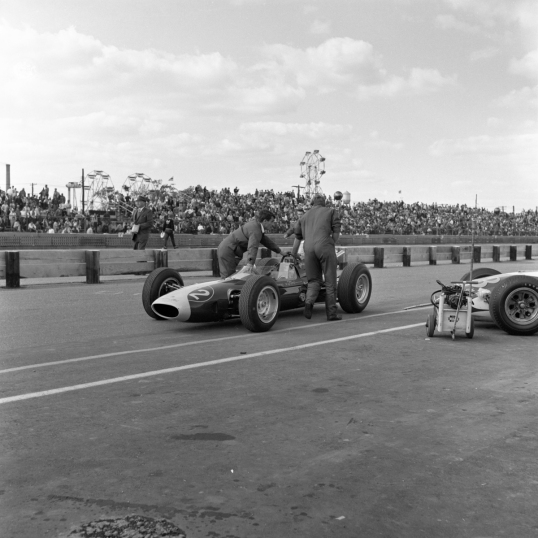“Where’s Clark…?”
 Incredibly, amazingly, Jim Clark and Dan Gurney arrived at the venerable Trenton State Fairgrounds in New Jersey ready to qualify and to race. They had slept for but a couple of hours at the nearby team motel; Oulton Park already seemed an age away. Both would drive their Indy and Milwaukee Lotus 29-Fords, although on this occasion the exhausts had been angled skywards in physical testimony to the sheer speed of the two rear-engined cars. At both of the preceding races, the drivers of the higher, front-engined roadsters had complained about the fumes caused by the lower exhaust flows from the two little Lotus. As it was by now clear that the older cars would inevitably be trailing the 29s, Colin Chapman (and designer Len Terry) agreed to re-angle the exhausts upwards. The ungainly mod (which also, as it turned out, provided a performance boost!) would thereafter be a reminder of all that was achieved by Team Lotus in America in 1963.
Incredibly, amazingly, Jim Clark and Dan Gurney arrived at the venerable Trenton State Fairgrounds in New Jersey ready to qualify and to race. They had slept for but a couple of hours at the nearby team motel; Oulton Park already seemed an age away. Both would drive their Indy and Milwaukee Lotus 29-Fords, although on this occasion the exhausts had been angled skywards in physical testimony to the sheer speed of the two rear-engined cars. At both of the preceding races, the drivers of the higher, front-engined roadsters had complained about the fumes caused by the lower exhaust flows from the two little Lotus. As it was by now clear that the older cars would inevitably be trailing the 29s, Colin Chapman (and designer Len Terry) agreed to re-angle the exhausts upwards. The ungainly mod (which also, as it turned out, provided a performance boost!) would thereafter be a reminder of all that was achieved by Team Lotus in America in 1963.
For coverage of the Trenton 200 I can do no better than to hand over to that excellent American writer, John Hearst Jnr, and to (the sadly now defunct) Sports Car Digest:
“The two-lap qualifications proved to be almost as exciting as the race itself,” wrote Hearst. “Knowing voices said that AJ Foyt’s one-lap record of 106.635 mph could not be beaten, for conditions weren’t ‘right’. Clouds polka-dotted the sky and outnumbered the sun. The day was cold and brisk, and the long grass in the infield was beaten flat by a gusty wind. The wind. That would be the problem.
“And it was…for some. Indy roasters and ‘spring cars’ made two laps apiece. Each driver fought to stay in the blacker part of the grey asphalt ribbon: ‘the groove’. Some were quick and skillfull while others worked with arms flailing and right foot stabbing in a furious exhibition of over/under oversteer. A couple reached the point of no return as their mounts went into gut-wrenching, rubber-burning slides.
“Dan Gurney’ (whose engine now had the 48mm longitudinal Weber carburettors) “took his turn. Dressed in plain overalls, with black helmet and leather face mask, first thoughts were, ‘He must have come to the wrong place!’ The little blue-and-white car sang its way around once, and then again. Accelerating earlier, and backing-off earlier, Dan made it all look so easy as he averaged 109.024 mph. AJ Foyt, 28 years old and twice USAC Champion, could manage no more than a shrug as his record fell.
“Minutes later, Jim Clark took his turn with a flourish, provided by promoter Sam Nunis. A local bagpipe band huffed and wheezed at ‘Scotland, the Brave’ as Clark, in his green-and-yellow car, was pushed out before the cheering fans on the grandstand straight. All work stopped. Wrenches were laid aside and heads came out from beneath raised hoods. Everyone knew what was going to happen.
“The crowd became silent. The only sounds were the skirling pipes and the wind. Then came the hum of the starter motor, followed by the high-pitched wail of the unmuffled, pushrod Ford V8. The young Scot was given a shove to engage first, and he was away.
“The air held one sound: a note that worked itself higher and higher up the scale. The car seemed to float around the track others had made appear so bumpy. Green flag, white flag and then the checker. It was over, and everyone knew – but by how much?
“Clark had just lowered Gurney’s newly-set record by 0.332 mph when he turned the mile over in 33.02 seconds, and was over 3 mph faster than Foyt’s old record.
“A weak smile was all that was offered in return as one roadster owner turned to his driver and cracked, ‘How do you spell ‘For Sale’?’
“Finally, the 26 starters were assembled, started and pushed away on the first of four warm-up laps. On the pole was Clark and next to him was Gurney. Both stifled yawns, for both had spent the night flying the Atlantic. Both had won races at Oulton Park the previous day and Gurney the previous weekend had won at Bridgehampton, where he had been the first to drive an American car, the Shelby Cobra, to victory in a World Manufacturers’ Championship race.
“The green flag was waved furiously and a roar shook the earth as 26 cars accelerated as one. Yet the sound of the Lotus-Fords was unmistakable, for they were two trumpets in an orchestra of tubas. Appearing comparatively relaxed, Clark and Gurney, nose to tail, pulled away from the 24 others. At first only a second, then two, then five, soon to be seven, ten, twelve, and more.
“Meanwhile others were having their problems. On lap six, Rodger Ward saw his USAC Championship hopes fizzle when a fuel line burst, covering him with the volatile stuff. Next to quit was Jim Hurtubise, whose fuel-laden car was bottoming through the turns. When the seat pan started to wear away, Jim started getting a little warm. Then his gas tank ruptured and Jim wisely gave up. Speechmaker Eddie Sachs retired, to be joined five laps later by Indy winner Parnelli Jones, whose magneto went sour.
“By now, Clark led Gurney and 12 seconds, who in turn led Foyt by 10 seconds. Clark had lapped every car in the field except Foyt. That was lap 49. On lap 50 everyone looked at everyone else and finally someone said it: ‘Where’s Clark?’
“The young Scot had pulled into the pits. A glance at his oil pressure gauge brought him in, and an ever-growing puddle of black under his car kept him in. Through for the day, the primrose-yellow-overalled driver” (the Hinchmans!) “climbed atop a nearby truck and joined Rodger Ward as a spectator. Englishman Colin Chapman, builder of the Lotus-Fords, stood by as the crew removed the engine cover, revealing a ruptured four-inch hose, used to join the chassis oil tube to the cast-aluminium ‘Fairlane’ engine. Unceremoniously, the car was shoved into its van.
“Gurney calmly kept his mount in first place. Foyt, however, closed the gap to seven seconds as three Offy types put Dan in a neat little box for some five laps. When they became committed to a line in a turn, he changed his, and eventually picked them off, one at a time. The Lotus held the upper hand.
“Mounting elation suddenly turned to depression for on lap 147 Gurney was followed down the main straight by a large cloud of white smoke. Dan backed off and cars he had just lapped, some for the fifth and sixth time, came streaming by him. Silently, with engine cut, he pulled into pit lane as Foyt, with a quick glance to the left, accepted the lead. Gurney’s acute disappointment was mirrored in the faces of his crew. And for many of the fans, the race was over, for they had come to ‘…See the Fabulous Lotus-Fords! See Jim Clark! See Dan Gurney!’
“An oil seal on an accessory drive on the front of the block had let go, causing Dan’s retirement. This was the reason given by one Ford representative (of almost 50 present) after almost an hour of searching by Chapman and crew.
“Foyt led for the remaining 53 laps. He not only won the race but the USAC Championship for the third time in his career. Over a lap behind, and finishing second and third, were Bud Tinglestad and Troy Ruttman, who brought the remaining crowd to their fee with some hearty dicing. It was a good race and an exciting race but for many it was over back on lap 147.
“Only ten cars finished. Foyt’s share of the $42,210 purse was nearly $12,000, which might just b e enough for a down-payment on a Lotus-Ford. Chapman said (and a Ford PR man verified it) that he will build cars for private owners after he fulfils his primary commitment to Ford. He refused, at present to state a price. And, according to a Dunlop tyre man who was present, the R6s the cars were shod with showed very little wear at Trenton and ‘…may be the answer to a no-change Indy’.
“When a Ford man was asked if these cars would run again next year at Indy, the answer was ‘No!’. When asked why, he answered, ‘…’cause we’re going to build new ones.’ The 1963 cars will be used for display and research and development.
“The capper of the day came when one railbird remarked that he didn’t think the Lotus-Ford were really that amazing after all. ‘Hell,’ he explained, ‘a guy in track shoes can beat a guy in combat boots any day of the week.”
Thanks again to Sports Car Digest for John’s reporting in the way of the classic, 1960s US sportswriter.
Additional notes: Dan would have at least been cheered by Troy Ruttman’s third place because he still rates Troy as one of the great, hidden-away American talents. (Ruttman won the 1952 Indy 500 at the age of 22 and showed his versatility with a strong Maserati 250F drive in the 1958 French GP at Reims.) With Jim’s hectic schedule precluding any sort of consistent commitment to a 1963-64 US test programme, young Bobby Marshman was duly hired by Team Lotus (financed by Lindsey Hopkins) to carry out development work on the new double overhead-cam engines. There was also talk after Trenton that the two Lotus failures had been indirectly caused by incidents during the shipping of parts. This was later rescinded when it was discovered that on Dan’s car a piston had fractured and thus damaged the oil line – but this does give a flavour of the sort of differences that quickly grew between Ford and Lotus (and between the Americans and the British). Hearst’s report, indeed, is remarkable for its objectivity. In most contemporary American publications, and particularly over at Car and Driver, the emphasis was very much on the Ford-Lotus cars, with Lotus, in the main, considered to be lucky, and slightly unworthy, partners. Sports Car Digest, by contrast, was a brilliant mix of Americana and Bernard Cahier. Need I say more.
So ended Jim’s 1963 American oval racing season. A win and a second. He would return to Trenton – and Indy, of course – in 1964.
“It had been hard work and a great deal of travelling for just three races,” he would write later in Jim Clark at the Wheel, “but it was worth it in the results we gained and the impact we made. I now have an ambition to drive the Lotus 29 on a road circuit but I suppose that dream will have to wait.”
Jim would, of course, drive the 1965 Lotus 38 Indy car up the Ste Ursanne hill-climb, as we have described elsewhere on these pages, but in 1963, after the US and Mexican GPs, there were American sports car races still to pursue. From New Jersey, meanwhile, the new World Champion took a 707 back to England for a different kind of race: the Snetterton Three Hours with the Normand Racing Lotus 23B.
Personal trainer? Gym? Nutritionist? “Racing keeps me fit,” said Jim. “Racing and getting to races. There’s no time for anything else.”
Captions (from top): looking slightly less elegant thanks to its angled exhausts, the Lotus 29-Fords nonetheless set the pace at Trenton. Jim, wearing his regular, peakless Bell Magnum but on this occasion (as per the USAC regularions) a shoulder harness, was leading easily before an oil leak forced his retirement; Dan then took over in the blue-and-white car – but retired with a broken piston. Note that they are running the same Dunlop-Halibrand wheel combination as Milwaukee; Dan Gurney, on board a 707, gives some idea of what it was like in 1963, when trans-Atlantic crossings were for drivers like Dan and Jim Clark as frequent as trips to the local market. Economy class was a little more spacious back then; the seat backs included a serious reading light; and everyone dressed for the occasion, regardless of the route or the timings Photographs: Ford Motor Company and LAT Photographic
It was initially difficult to find images from the 1963 Trenton 200. I wrote to most of the leading US journalists for leads; I contacted local, New Jersey, newspapers and agencies. No luck. Then, the day after the above report was published, I received this bundle (below) from the Ford Motor Company. To say I’m delighted is massively to under-state. Finally, we can gain a picture of what it was like back then on the track that is no longer. Look at the old grandstand; look at Jim Endruweit and the Lotus mechanics, all neat in green. Look at the sandy infield; look at the Fairground in the background. Look at the 29s out there in the groove. That’s the rear-engined Kurtis-Offy of the Canadian, Ed Kostenuk, that Jim is lapping. That looks like the nose of Parnelli’s Watson on the right as Jim’s 29 is pushed backwards down the pit lane – and that’s Roger McCluskey’s Vita Fresh Orange Juice Special behind Jim’s car at bottom. Again, many thanks to FoMoCo.


















Pingback: “Where’s Clark…?” | HolaQueretaro
great work PW great work … there *are* treasures buried out there and you are just the man to find them … in the footsteps of Jones (Indiana that is).
Thanks for putting this together – a fascinating read – pure magic!
You’re very welcome. Thanks for writing.
Well…sometimes…if I’m lucky…:)
Pingback: “Where’s Clark…?” - A Las Carreras
The R6 tire you noted was, of course, a Dunlop. Something I have never seen noted before. Chapman got by with it here, but not at Indy in ’64.
Always great to read more about my idol Jim Clark.
He was incredible and my favourite driver of them all. When he was taken it was like losing a family member. I was devastated and it seemed to hit everybody hard, and I mean every body not just the race car fraternity. For me, Jimmy was and still is the Greatest race car driver of them all, God bless you Jimmy.